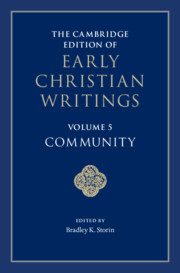Book contents
- The cambridge edition of EARLY CHRISTIAN WRITINGS
- The cambridge edition of EARLY CHRISTIAN WRITINGS
- the cambridge edition of EARLY CHRISTIAN WRITINGS
- Copyright page
- Dedication
- Contents
- Notes on Contributors
- Note on the Texts and Translations
- Preface
- Series Introduction
- Introduction
- Part I Entering the Community
- Part II Forming and Overseeing the Community
- Part III Imagining the Community
- 16 Tertullian of Carthage, On Repentance and On Modesty 1–4, 21–22
- 17 Cyprian of Carthage, On the Oneness of the Catholic Church (Second Edition)
- 18 Augustine of Hippo, Letter 87 to Emeritus of Caesarea
- 19 Augustine of Hippo, Sermons 227–229
- 20 Pseudo-Dionysius, On the Ecclesiastical Hierarchy 1, 5–7
- Part IV Policing the Community
- Suggestions for Further Reading
- Scriptural Index
19 - Augustine of Hippo, Sermons 227–229
from Part III - Imagining the Community
Published online by Cambridge University Press: 19 May 2025
- The cambridge edition of EARLY CHRISTIAN WRITINGS
- The cambridge edition of EARLY CHRISTIAN WRITINGS
- the cambridge edition of EARLY CHRISTIAN WRITINGS
- Copyright page
- Dedication
- Contents
- Notes on Contributors
- Note on the Texts and Translations
- Preface
- Series Introduction
- Introduction
- Part I Entering the Community
- Part II Forming and Overseeing the Community
- Part III Imagining the Community
- 16 Tertullian of Carthage, On Repentance and On Modesty 1–4, 21–22
- 17 Cyprian of Carthage, On the Oneness of the Catholic Church (Second Edition)
- 18 Augustine of Hippo, Letter 87 to Emeritus of Caesarea
- 19 Augustine of Hippo, Sermons 227–229
- 20 Pseudo-Dionysius, On the Ecclesiastical Hierarchy 1, 5–7
- Part IV Policing the Community
- Suggestions for Further Reading
- Scriptural Index
Summary
Among his many duties as bishop of Hippo in North Africa, Augustine (354–430) oversaw the reception of converts into the church. When newcomers to Christianity were ready to prepare for baptism, they were designated as catechumens. The catechumenate was a period of training, often lasting several years, in which newcomers learned how to live as Christians. At the beginning of each Lent, those catechumens who wished to be baptized at the upcoming Easter would submit their names and thereby formally become “petitioners” (competentes). During Lent the petitioners engaged in a number of ascetical and ritual practices designed to complete their initiation into the Christian way of life. These included fasting, undergoing periodic exorcisms, and receiving special instruction from the bishop by listening to sermons that covered a broad range of Christian doctrine and practice. Two weeks before Easter, petitioners participated in a ceremony known as the traditio symboli, the “handing over” of the creed. At this ceremony the bishop formally recited the creed, with the expectation that afterward the petitioners would memorize it. There was a similar ceremony that “handed over” the Lord’s prayer (traditio orationis). At the Easter Vigil, the petitioners would “hand back” the creed (redditio symboli) and the Lord’s prayer (redditio orationis) by reciting them before the congregation and fully participate in the Eucharistic liturgy for the first time, in the course of which they received the sacraments of initiation: baptism, chrismation, and Eucharist. During the Easter octave – the eight days from Easter Sunday to the following Sunday, counting inclusively – the newly baptized, whom Augustine called “newborns,” would attend sermons that unpacked the meaning of the sacraments they had just experienced and received at the Easter Vigil.
Information
- Type
- Chapter
- Information
- The Cambridge Edition of Early Christian Writings , pp. 355 - 364Publisher: Cambridge University PressPrint publication year: 2025
